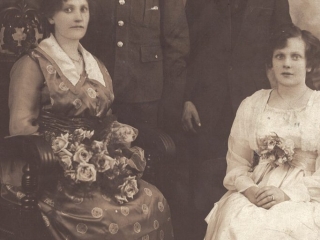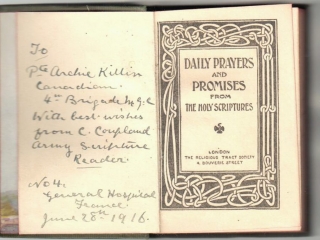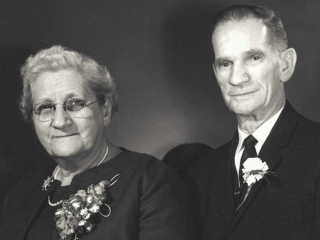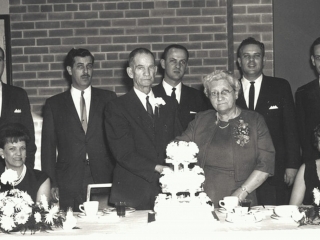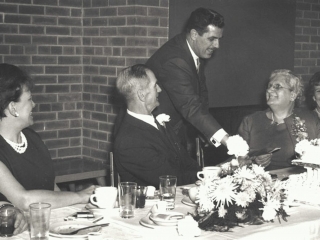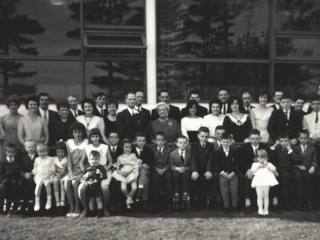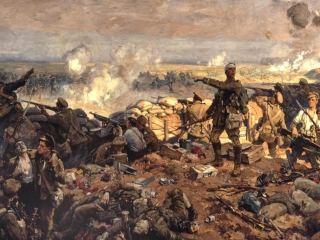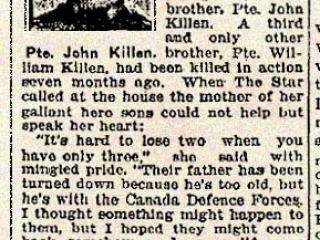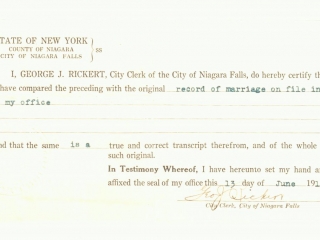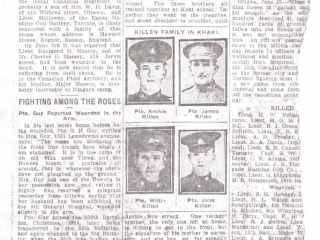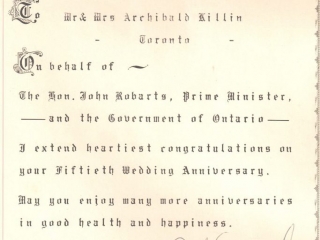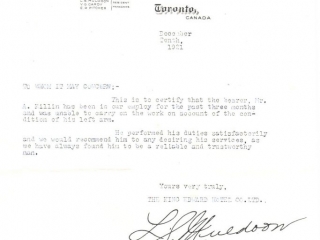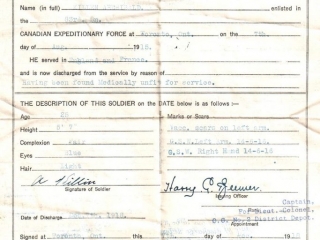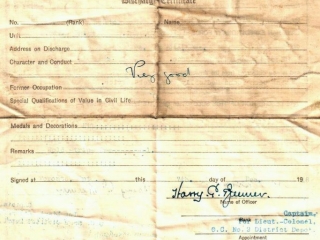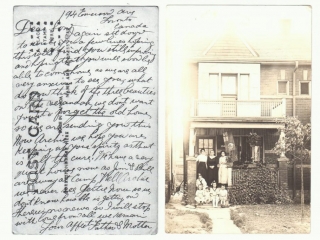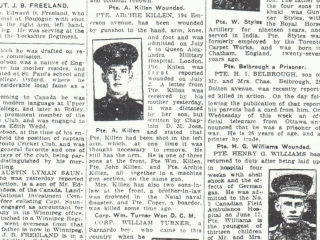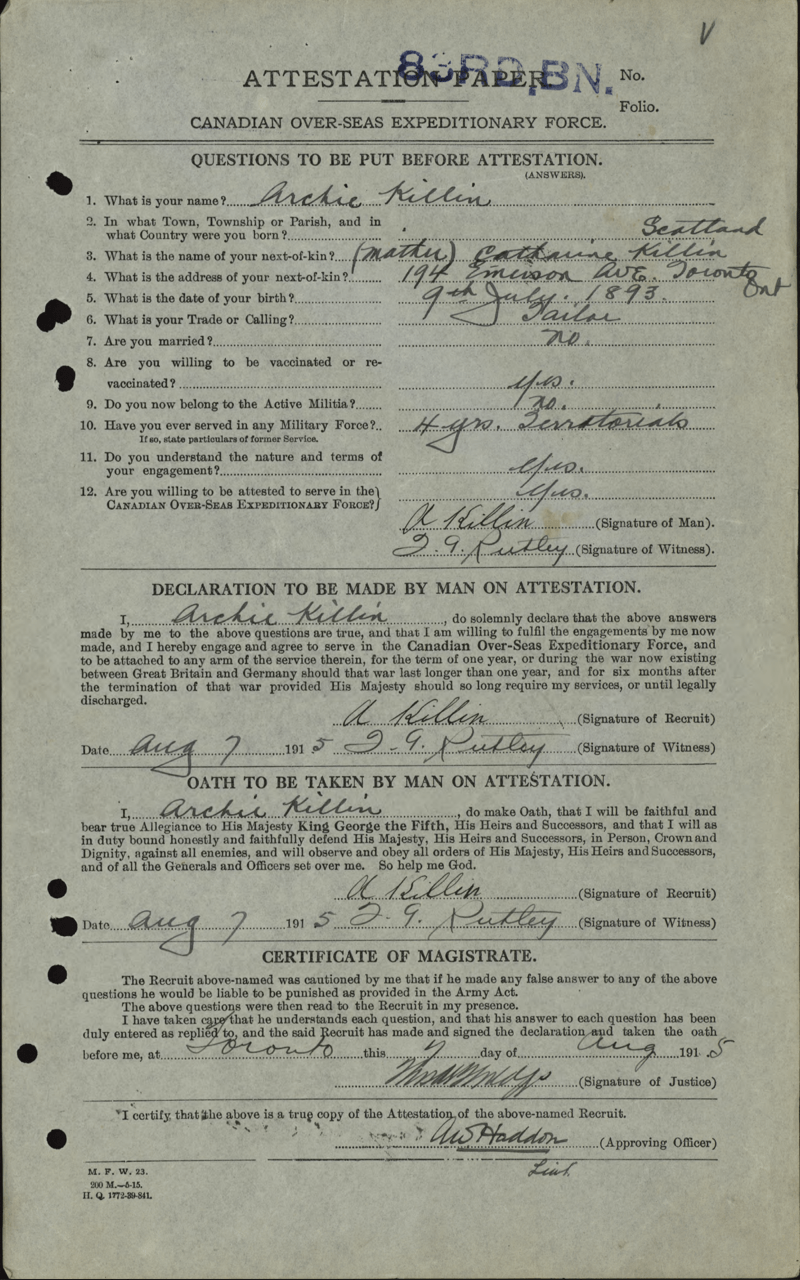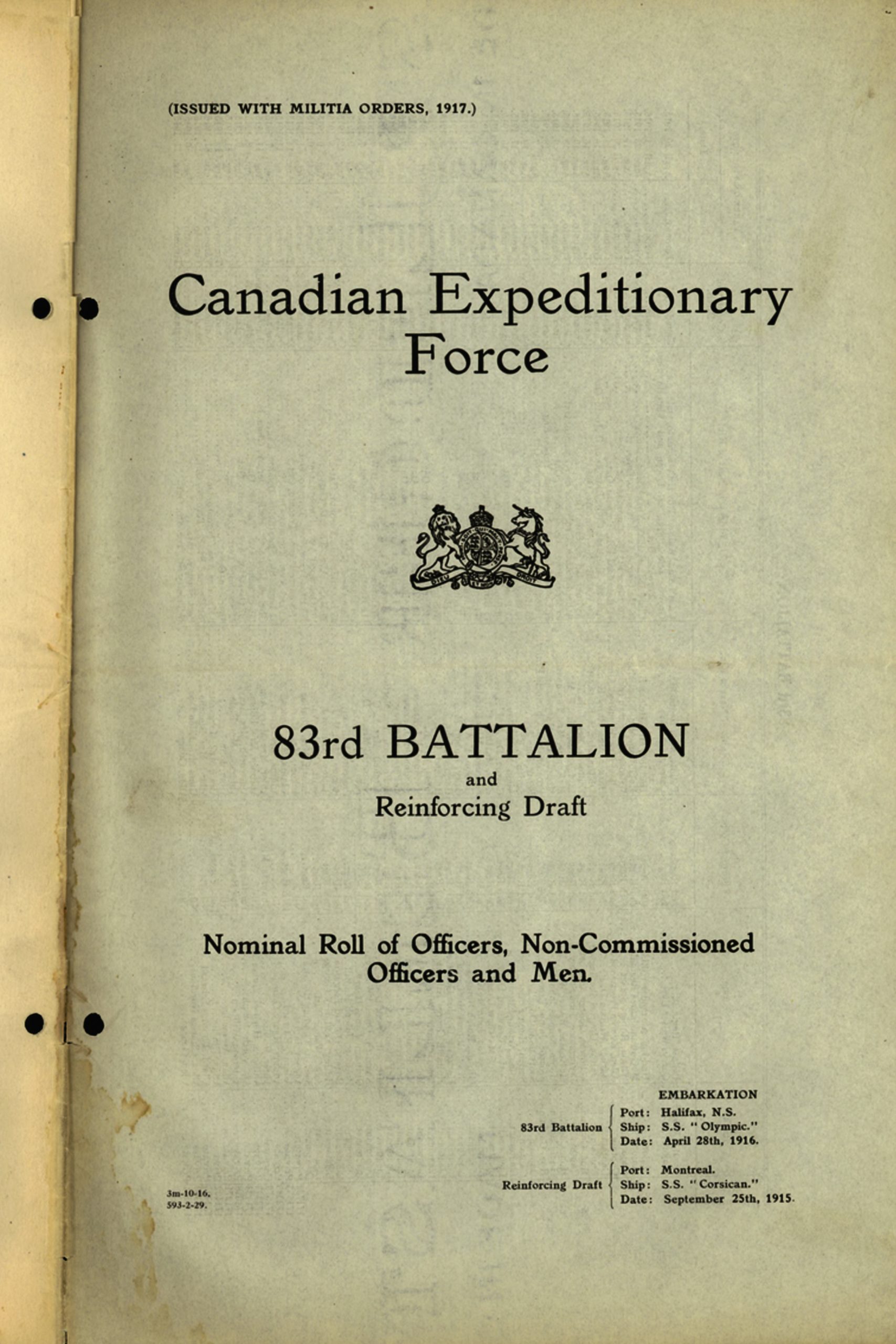Archibald (Archie) Killin
1893-1966

Archibald (Archie) Killin
Son of James and Catherine Killin, born in Ayr, Ayrshire Scotland July 9 th, 1893 Died October 8th, 1966. Age 73 years.
(Note that there appears to be an error on the stone stating that Archie was 77 years when he died but since he was born in 1893 and died in 1966 he was presumably actually in his 74th year. This apparent error was carried over from the first stone to the second/existing stone.)
Pte. Archie Killin (# 171143, member of the 4th Canadian Machine Gun Company, 2nd Canadian Division) was Wounded In Action on June 4th, 1916, the first few days of the Battle of Mount Sorrel in France. (part of the battles for the Ypres Salient of the Western Front of The War To End All Wars AKA: The Great War for Civilization 1914-1918). Some of the most severe wounds suffered by Archie (then age 22) included; dislocated fingers, various shrapnel & gunshot wounds to both hands, his left arm and at least one knee and foot. (See Archie Killin Attestation Paper 1915 starting on pages 15 of 86 for a number of documents that seem to have started keeping medical tracking of his injuries from the first field hospital he was taken to after being taken from the battle field on June 4th, 1916 per page # 16). Archie would later have his lower left arm amputated and wear a prosthesis for the remainder of his long (relative to his siblings) and productive life.
Archie, lived with his parents and siblings at 194 Emerson Ave. Toronto, listed his occupation as “Tailor” and had served 4 years in the Territorials reserves before his August 7th, 1915 enlistment. (See Archie Killin Attestation Paper 1915, pages # 1 & 2). Attached you will find a photo post card that shows the family home in 1917 and a 2019 Google Street photo of the same house. Note the sapling of 1917 turned into quite a mature tree in 102 years and in 2019 appeared to be one of only a few trees remaining on this block.
Archie left hospital in Liverpool England, boarding the hospital ship “Letitia” for Canada on April 11th, 1917. The address given for Archie’s return to Toronto was 225 Wallace Avenue. If you go to page # 19 or 86 you will see that Archie was given a “leave of absence” to get married on February 5th, 1918. It is assumed that he initially returned to the 194 Emerson Ave. family home and then, upon his marriage to Jean (Dunlop) Killin, moved to the Wallace Ave. home.
By the time Archie returned home, the family was to hear of the passing of his brother John. (see attached Toronto Star article). John had married in Glasgow / Scotland shortly before leaving to join his bothers in the trenches and quite possibly unknown to him had become a father. John’s wife (Jean) and son (John) traveled from Scotland to join John’s family in Toronto, presumably after hearing of his death and was to later marry Archie.
At some point, because Archie could not return to his Tailor profession after the war, he had a job at the King Edward Hotel in Toronto for three months. It appears from the attached reference letter from the then manager that Archie’s war injuries prevented him from continuing to fulfill his duties. It may be at this point that he was convinced and helped by his cousin (Tom Neil) to work for free for the City of Toronto in the Health Inspector (restaurants) department (effectively as an unpaid intern) after which time he was taken on as a full time employee and worked until his retirement.
Most of the family (Jean’s children) where unaware that John and Jean were married and that they had a child until shortly after Jean passed in 1972 and that the “A.” in Mrs. A. Killin was Archie (John’s brother).
Archie enlisted with his two brothers, John & William, August 7th, 1915 in Toronto into the 83rd Battalion BEF, 4th Canadian Machine Gun Company (see page # 25 of 28 of Canadian Expeditionary Force, 83rd Battalion and Reinforcement Draft).
Also attached are two Toronto news articles that mention Archie and his brothers. A reference in one of these news articles refers to the three brothers being in the trenches together in the same machine gun company. Attached is a copy of a painting of the battle at Mount Sorrel that will give you an idea of what the three brothers encountered during the action they initially encountered upon entering the war. Look to the middle of the painting and you will see a group of three men working as a machine gun crew. Could this have been the three Killin boys? A century later (2016) one of Archie’s great grandsons (Sargent Jeffrey Thomas Killin, a member of the Royal Regiment of Canada Reserves) would be on the parade ground as part of a memorial service of this famous regimental battle that continues to be observed as a defining battle for this regiment, held at the Fort York Armories in Toronto.
Attached is a photo post card sent to Archie, that shows the family home in 1917 with their Mother, presumably their two sisters and some unknown children. Also attached is a 2019 photo of the same house. Note the tree that in 1917 was a sapling and in 2019 is a mature tree and one of the few on the street.
Archie & Jean
Archie married Jean in small ceremony in Niagara Falls New York on Feb 5th, 1918. Present as witnesses were Archie’s younger and only surviving brother James (1900-1966) and their older sister Catherin Lillian (Killin) Couper (1892-1947). (Wedding photo attached.)
The reason for this small and quiet marriage, held outside of Canada/Toronto with only two witnesses, was that at this time it was not legal in the British Commonwealth for a man to be married to his brother’s wife.
This information, that Jean was first married to Archie’s brother John shortly before John went off to War and was Killed in Action, was only discovered upon the passing of Jean in 1972. As it turns out, when John went off to war Jean was pregnant with a son (John 1917-1970) who was raised by Archie and Jean as their first child together. Their sons Bill & Don discovered this part of our family history one evening while putting together their Mom’s personal documents/affairs upon her passing. Bill’s son Kenneth (14 years old at the time) was also present during this fascinating moment of discovery.
You can see that even the Ontario Government was under the impression that they were in fact married in 1916 by the 50th Anniversary congratulatory certificate from the then Premier’s office dated 1966.
Once married, Archie and Jean built a life together that included having nine more children with seven surviving childhood. It was from this union that most of the family in Canada can attribute a direct connection.
Reference material Canadian Expeditionary Force, 83rd Battalion and Reinforcement Draft AND Archie’s Attestation 1915)
83rd Battalion Background Information Organized in July 1915 under the command of Lieutenant-Colonel R. Pellatt. Authorization published in General Order 103a of 15 August 1915. Mobilized at Toronto. Recruited in Toronto. Draft of 250 sent to England in September 1915. Embarked from Halifax 1 May 1916 aboard OLYMPIC. Disembarked England 6 May 1916. Strength: 35 officers, 1035 other ranks. Draft of 300 to 4th and 5th Canadian Mounted Rifles in June 1916. Draft of 70 to 3rd Battalion in June 1916. Draft of 30 to 19th Battalion in July 1916. Absorbed by 12th Canadian Reserve Battalion on 7 July 1916. Disbanded by Privy Council Order 1366 and 1863 of 21 May and 6 July 1917. Bugle band. Perpetuated by The Queen’s Own Rifles of Canada. 83rd Battalion (Queen's Own Rifles of Canada), CEF From Wikipedia, the free encyclopedia Jump to navigationJump to search The 83rd Battalion (Queen's Own Rifles of Canada), CEF was an infantry battalion of the Canadian Expeditionary Force during the Great War. The 83rd Battalion was authorized on 10 July 1915 and embarked for Britain on 28 April 1916. It provided reinforcements for the Canadian Corps until 7 July 1916, when its personnel were absorbed by the 12th Reserve Battalion, CEF. The battalion was subsequently disbanded on 21 May 1917.[1] The 83rd Battalion recruited in and was mobilized at Toronto, Ontario.[2] The 83rd Battalion was commanded by Lt.-Col. R. Pellatt from 1 May 1916 to 17 August 1916.[3] The 83rd Battalion was awarded the battle honour THE GREAT WAR 1916.[4] The 83rd Battalion, CEF is perpetuated by The Queen's Own Rifles of Canada.[5] References[edit] 1. ^ Canadian Forces Publication A-DH-267-003 Insignia and Lineages of the Canadian Forces. Volume 3: Combat Arms Regiments. 2. ^ Meek, John F. Over the Top! The Canadian Infantry in the First World War. Orangeville, Ont.: The Author, 1971. ISBN 0906158109 3. ^ Meek, John F. Over the Top! The Canadian Infantry in the First World War. Orangeville, Ont.: The Author, 1971. ISBN 0906158109 4. ^ Meek, John F. Over the Top! The Canadian Infantry in the First World War. Orangeville, Ont.: The Author, 1971. ISBN 0906158109 5. ^ Canadian Forces Publication A-DH-267-003 Insignia and Lineages of the Canadian Forces. Volume 3: Combat Arms Regiments. Sources[edit] Canadian Expeditionary Force 1914–1919 by Col. G.W.L. Nicholson, CD, Queen's Printer, Ottawa, Ontario, 1962
4th Canadian Machine Gun Company: Guide to Sources Relating to Units of the Canadian Expeditionary Force 6 4th Canadian Machine Gun Company Background Information Organized in Belgium in December 1915 as the 4th Canadian Infantry Brigade Machine Gun Company. Commanded by Captain J. Edwards. Composed of machine gun sections of the 4th Brigade’s infantry battalions. Redesignated as 4th Canadian Machine Gun Company in July 1916. The 4th, 5th, 6th and 14th Canadian Machine Gun Companies were detached from their respective infantry brigades in September 1917 and formed the 4th, 5th, 6th and 14th Companies of the 2nd Canadian Divisional Machine Gun Battalion. Reorganized on 21 March 1918 to form the 2nd Battalion, Canadian Machine Gun Corps. Sources In this section, the text in bold is the main topic and the indented part is the archival reference. Use the archival reference to order the document. War diary, 1 Jan. 1916 - 31 March 1918 RG 9 III-D-3, vol. 4982, folder 604 Historical record RG 9 III-C-1, vol. 3931, folder 17, file 5 Historical record RG 9 III-D-1, vol. 4686, folder 36, file 18 Circular re badges RG 9 III-D-1, vol. 4686, folder 36, file 19 Operations. Mount Sorrel, 2 June 1916 RG 9 III-D-1, vol. 4686, folder 36, file 20 Operations. Fresnoy, 8 May 1917 RG 9 III-D-1, vol. 4686, folder 36, file 21 Operations. Hill 70, 16 Aug. 1917 RG 9 III-D-1, vol. 4686, folder 36, file 22 Organization, 10-20 Feb. 1917 RG 9 III-C-1, vol. 3937, folder 35, file 2 Organization RG 9 III-C-3, vol. 4056, folder 32, file 10 Guide to Sources Relating to Units of the Canadian Expeditionary Force 7 Operation orders, 15 Feb. - 3 March 1918 RG 9 III-C-4, vol. 4354, folder 3, file 26 Canadian Records Office file RG 9 III-B-1, vol. 1087, files M-145-4 and M-160-4
Canadian Machine Gun Corps https://www.canadiansoldiers.com/corpsbranches/machineguncorps.htm The Royal Regiment of Canada The First World War YPRES, 1915, '17; Gravenstafel; St. Julien; FESTUBERT, 1915; MOUNT SORREL; SOMME, 1916, '18; Pozières; Flers Courcelette; Ancre Heights; ARRAS, 1917, '18; Vimy, 1917; Arleux; Scarpe, 1917, '18; HILL 70; Passchendaele; AMIENS; Drocourt-Quéant; HINDENBURG LINE; Canal du Nord; Cambrai, 1918; PURSUIT TO MONS; FRANCE AND FLANDERS, 1915-'18. https://www.canada.ca/en/department-national-defence/services/military-history/history-heritage/official-military-history-lineages/lineages/infantry-regiments/royal-regiment.html
Battle of Mont Sorrel From Wikipedia, the free encyclopedia Jump to navigationJump to search Battle of Mont Sorrel Part of the Ypres Salient along the Western Front of World War I
Restored battlefield map of positions occupied on 4 June 1916 The Battle of Mont Sorrel (Battle of Mount Sorrel, Battle of Hill 62) was a local operation in World War I by three divisions of the British Second Army and three divisions of the German 4th Army in the Ypres Salient, near Ypres, Belgium, from 2 to 13 June 1916. To divert British resources from the build-up being observed on the Somme, the XIII (Royal Württemberg) Corps and the 117th Infantry Division attacked an arc of high ground defended by the Canadian Corps. The German forces captured the heights at Mount Sorrel and Tor Top, before entrenching on the far slope of the ridge. Following a number of attacks and counterattacks, two divisions of the Canadian Corps, supported by the 20th Light Division and Second Army siege and howitzer battery groups, recaptured the majority of their former positions.
https://en.wikipedia.org/wiki/Battle_of_Mont_Sorrel
Son of James and Catherine Killin, born in Ayr, Ayrshire Scotland July 9 th, 1893 Died October 8th, 1966. Age 73 years.
(Note that there appears to be an error on the stone stating that Archie was 77 years when he died but since he was born in 1893 and died in 1966 he was presumably actually in his 74th year. This apparent error was carried over from the first stone to the second/existing stone.)
Pte. Archie Killin (# 171143, member of the 4th Canadian Machine Gun Company, 2nd Canadian Division) was Wounded In Action on June 4th, 1916, the first few days of the Battle of Mount Sorrel in France. (part of the battles for the Ypres Salient of the Western Front of The War To End All Wars AKA: The Great War for Civilization 1914-1918). Some of the most severe wounds suffered by Archie (then age 22) included; dislocated fingers, various shrapnel & gunshot wounds to both hands, his left arm and at least one knee and foot. (See Archie Killin Attestation Paper 1915 starting on pages 15 of 86 for a number of documents that seem to have started keeping medical tracking of his injuries from the first field hospital he was taken to after being taken from the battle field on June 4th, 1916 per page # 16). Archie would later have his lower left arm amputated and wear a prosthesis for the remainder of his long (relative to his siblings) and productive life.
Archie, lived with his parents and siblings at 194 Emerson Ave. Toronto, listed his occupation as “Tailor” and had served 4 years in the Territorials reserves before his August 7th, 1915 enlistment. (See Archie Killin Attestation Paper 1915, pages # 1 & 2). Attached you will find a photo post card that shows the family home in 1917 and a 2019 Google Street photo of the same house. Note the sapling of 1917 turned into quite a mature tree in 102 years and in 2019 appeared to be one of only a few trees remaining on this block.
Archie left hospital in Liverpool England, boarding the hospital ship “Letitia” for Canada on April 11th, 1917. The address given for Archie’s return to Toronto was 225 Wallace Avenue. If you go to page # 19 or 86 you will see that Archie was given a “leave of absence” to get married on February 5th, 1918. It is assumed that he initially returned to the 194 Emerson Ave. family home and then, upon his marriage to Jean (Dunlop) Killin, moved to the Wallace Ave. home.
By the time Archie returned home, the family was to hear of the passing of his brother John. (see attached Toronto Star article). John had married in Glasgow / Scotland shortly before leaving to join his bothers in the trenches and quite possibly unknown to him had become a father. John’s wife (Jean) and son (John) traveled from Scotland to join John’s family in Toronto, presumably after hearing of his death and was to later marry Archie.
At some point, because Archie could not return to his Tailor profession after the war, he had a job at the King Edward Hotel in Toronto for three months. It appears from the attached reference letter from the then manager that Archie’s war injuries prevented him from continuing to fulfill his duties. It may be at this point that he was convinced and helped by his cousin (Tom Neil) to work for free for the City of Toronto in the Health Inspector (restaurants) department (effectively as an unpaid intern) after which time he was taken on as a full time employee and worked until his retirement.
Most of the family (Jean’s children) where unaware that John and Jean were married and that they had a child until shortly after Jean passed in 1972 and that the “A.” in Mrs. A. Killin was Archie (John’s brother).
Archie enlisted with his two brothers, John & William, August 7th, 1915 in Toronto into the 83rd Battalion BEF, 4th Canadian Machine Gun Company (see page # 25 of 28 of Canadian Expeditionary Force, 83rd Battalion and Reinforcement Draft).
Also attached are two Toronto news articles that mention Archie and his brothers. A reference in one of these news articles refers to the three brothers being in the trenches together in the same machine gun company. Attached is a copy of a painting of the battle at Mount Sorrel that will give you an idea of what the three brothers encountered during the action they initially encountered upon entering the war. Look to the middle of the painting and you will see a group of three men working as a machine gun crew. Could this have been the three Killin boys? A century later (2016) one of Archie’s great grandsons (Sargent Jeffrey Thomas Killin, a member of the Royal Regiment of Canada Reserves) would be on the parade ground as part of a memorial service of this famous regimental battle that continues to be observed as a defining battle for this regiment, held at the Fort York Armories in Toronto.
Attached is a photo post card sent to Archie, that shows the family home in 1917 with their Mother, presumably their two sisters and some unknown children. Also attached is a 2019 photo of the same house. Note the tree that in 1917 was a sapling and in 2019 is a mature tree and one of the few on the street.
Archie & Jean
Archie married Jean in small ceremony in Niagara Falls New York on Feb 5th, 1918. Present as witnesses were Archie’s younger and only surviving brother James (1900-1966) and their older sister Catherin Lillian (Killin) Couper (1892-1947). (Wedding photo attached.)
The reason for this small and quiet marriage, held outside of Canada/Toronto with only two witnesses, was that at this time it was not legal in the British Commonwealth for a man to be married to his brother’s wife.
This information, that Jean was first married to Archie’s brother John shortly before John went off to War and was Killed in Action, was only discovered upon the passing of Jean in 1972. As it turns out, when John went off to war Jean was pregnant with a son (John 1917-1970) who was raised by Archie and Jean as their first child together. Their sons Bill & Don discovered this part of our family history one evening while putting together their Mom’s personal documents/affairs upon her passing. Bill’s son Kenneth (14 years old at the time) was also present during this fascinating moment of discovery.
You can see that even the Ontario Government was under the impression that they were in fact married in 1916 by the 50th Anniversary congratulatory certificate from the then Premier’s office dated 1966.
Once married, Archie and Jean built a life together that included having nine more children with seven surviving childhood. It was from this union that most of the family in Canada can attribute a direct connection.
Reference material Canadian Expeditionary Force, 83rd Battalion and Reinforcement Draft AND Archie’s Attestation 1915)
83rd Battalion Background Information Organized in July 1915 under the command of Lieutenant-Colonel R. Pellatt. Authorization published in General Order 103a of 15 August 1915. Mobilized at Toronto. Recruited in Toronto. Draft of 250 sent to England in September 1915. Embarked from Halifax 1 May 1916 aboard OLYMPIC. Disembarked England 6 May 1916. Strength: 35 officers, 1035 other ranks. Draft of 300 to 4th and 5th Canadian Mounted Rifles in June 1916. Draft of 70 to 3rd Battalion in June 1916. Draft of 30 to 19th Battalion in July 1916. Absorbed by 12th Canadian Reserve Battalion on 7 July 1916. Disbanded by Privy Council Order 1366 and 1863 of 21 May and 6 July 1917. Bugle band. Perpetuated by The Queen’s Own Rifles of Canada. 83rd Battalion (Queen's Own Rifles of Canada), CEF From Wikipedia, the free encyclopedia Jump to navigationJump to search The 83rd Battalion (Queen's Own Rifles of Canada), CEF was an infantry battalion of the Canadian Expeditionary Force during the Great War. The 83rd Battalion was authorized on 10 July 1915 and embarked for Britain on 28 April 1916. It provided reinforcements for the Canadian Corps until 7 July 1916, when its personnel were absorbed by the 12th Reserve Battalion, CEF. The battalion was subsequently disbanded on 21 May 1917.[1] The 83rd Battalion recruited in and was mobilized at Toronto, Ontario.[2] The 83rd Battalion was commanded by Lt.-Col. R. Pellatt from 1 May 1916 to 17 August 1916.[3] The 83rd Battalion was awarded the battle honour THE GREAT WAR 1916.[4] The 83rd Battalion, CEF is perpetuated by The Queen's Own Rifles of Canada.[5] References[edit] 1. ^ Canadian Forces Publication A-DH-267-003 Insignia and Lineages of the Canadian Forces. Volume 3: Combat Arms Regiments. 2. ^ Meek, John F. Over the Top! The Canadian Infantry in the First World War. Orangeville, Ont.: The Author, 1971. ISBN 0906158109 3. ^ Meek, John F. Over the Top! The Canadian Infantry in the First World War. Orangeville, Ont.: The Author, 1971. ISBN 0906158109 4. ^ Meek, John F. Over the Top! The Canadian Infantry in the First World War. Orangeville, Ont.: The Author, 1971. ISBN 0906158109 5. ^ Canadian Forces Publication A-DH-267-003 Insignia and Lineages of the Canadian Forces. Volume 3: Combat Arms Regiments. Sources[edit] Canadian Expeditionary Force 1914–1919 by Col. G.W.L. Nicholson, CD, Queen's Printer, Ottawa, Ontario, 1962
4th Canadian Machine Gun Company: Guide to Sources Relating to Units of the Canadian Expeditionary Force 6 4th Canadian Machine Gun Company Background Information Organized in Belgium in December 1915 as the 4th Canadian Infantry Brigade Machine Gun Company. Commanded by Captain J. Edwards. Composed of machine gun sections of the 4th Brigade’s infantry battalions. Redesignated as 4th Canadian Machine Gun Company in July 1916. The 4th, 5th, 6th and 14th Canadian Machine Gun Companies were detached from their respective infantry brigades in September 1917 and formed the 4th, 5th, 6th and 14th Companies of the 2nd Canadian Divisional Machine Gun Battalion. Reorganized on 21 March 1918 to form the 2nd Battalion, Canadian Machine Gun Corps. Sources In this section, the text in bold is the main topic and the indented part is the archival reference. Use the archival reference to order the document. War diary, 1 Jan. 1916 - 31 March 1918 RG 9 III-D-3, vol. 4982, folder 604 Historical record RG 9 III-C-1, vol. 3931, folder 17, file 5 Historical record RG 9 III-D-1, vol. 4686, folder 36, file 18 Circular re badges RG 9 III-D-1, vol. 4686, folder 36, file 19 Operations. Mount Sorrel, 2 June 1916 RG 9 III-D-1, vol. 4686, folder 36, file 20 Operations. Fresnoy, 8 May 1917 RG 9 III-D-1, vol. 4686, folder 36, file 21 Operations. Hill 70, 16 Aug. 1917 RG 9 III-D-1, vol. 4686, folder 36, file 22 Organization, 10-20 Feb. 1917 RG 9 III-C-1, vol. 3937, folder 35, file 2 Organization RG 9 III-C-3, vol. 4056, folder 32, file 10 Guide to Sources Relating to Units of the Canadian Expeditionary Force 7 Operation orders, 15 Feb. - 3 March 1918 RG 9 III-C-4, vol. 4354, folder 3, file 26 Canadian Records Office file RG 9 III-B-1, vol. 1087, files M-145-4 and M-160-4
Canadian Machine Gun Corps https://www.canadiansoldiers.com/corpsbranches/machineguncorps.htm The Royal Regiment of Canada The First World War YPRES, 1915, '17; Gravenstafel; St. Julien; FESTUBERT, 1915; MOUNT SORREL; SOMME, 1916, '18; Pozières; Flers Courcelette; Ancre Heights; ARRAS, 1917, '18; Vimy, 1917; Arleux; Scarpe, 1917, '18; HILL 70; Passchendaele; AMIENS; Drocourt-Quéant; HINDENBURG LINE; Canal du Nord; Cambrai, 1918; PURSUIT TO MONS; FRANCE AND FLANDERS, 1915-'18. https://www.canada.ca/en/department-national-defence/services/military-history/history-heritage/official-military-history-lineages/lineages/infantry-regiments/royal-regiment.html
Battle of Mont Sorrel From Wikipedia, the free encyclopedia Jump to navigationJump to search Battle of Mont Sorrel Part of the Ypres Salient along the Western Front of World War I
Restored battlefield map of positions occupied on 4 June 1916 The Battle of Mont Sorrel (Battle of Mount Sorrel, Battle of Hill 62) was a local operation in World War I by three divisions of the British Second Army and three divisions of the German 4th Army in the Ypres Salient, near Ypres, Belgium, from 2 to 13 June 1916. To divert British resources from the build-up being observed on the Somme, the XIII (Royal Württemberg) Corps and the 117th Infantry Division attacked an arc of high ground defended by the Canadian Corps. The German forces captured the heights at Mount Sorrel and Tor Top, before entrenching on the far slope of the ridge. Following a number of attacks and counterattacks, two divisions of the Canadian Corps, supported by the 20th Light Division and Second Army siege and howitzer battery groups, recaptured the majority of their former positions.
https://en.wikipedia.org/wiki/Battle_of_Mont_Sorrel

